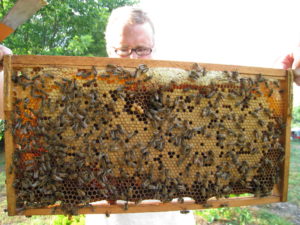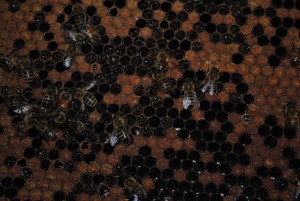As posted back on the 19th, I actually picked up a swarm of bees this month in Richmond, Virginia! October? Well, I’ve been through that before. A swarm caught in August requires work to get through our Winters. One caught in September requires a lot of work and you are still at high risk. I would have to say that the chance that an October swarm will make it is next to zilch. Fortunately for me, I love a challenge.
Once I got the swarm back to my house, I put 5 frames of drawn wax with 5 frames of foundation in a Deep and placed a top feeder on them. Most will ask ‘why didn’t you put them in a Nuc?!’ It’s a valid question. The main reason I put them into the Deep was because of their need for feed. I know you can feed a Nuc, but I have found that my Beemax top feeders (for full-sized hives only – they have something similar for Nucs, but I do not own any) are the absolute best mechanism for me to get syrup into hives. It was Oct 19! I had no time to mess with an entrance feeder (plus, I was worried about robbing). So, I gave them drawn wax to immediately start laying in and foundation (in case they were a swarm and were ready to build wax, like Spring swarms do.) I dropped the feeder on them and began feeding them.
At the last moment, I dropped another deep frame that I had which was mostly honey but had been ravaged by SHB back in July. I had frozen the frame for 3 days and kept it in my basement since then. Although I knew some of the honey was shot, I figured some would be fine for them (I had already seen the bees clean out 2 similar frames when I placed them out in the open in my Nuc yard earlier in the year, so I knew there was value in what the frame had in it.)
The problem is that these frames have a different scent to them. It seems to really draw bees quickly, which I really didn’t think about when I dropped it into the October swarm. The next day, it looked like I had a robbing situation. As always (and usually to my detriment – and the bees!), I try to get into the heads of my bees – I figured that we have a new swarm of bees, moved about while being captured and now in a new location (trying to get oriented) and I have created a robbing scenario! Before they could even get their feet under them! Now, it’s going to be hard to follow my twisted logic, but hang in there…
Seeing what I thought was robbing, I looked closer and could see bees fanning OUT of the hive. At that exact time, I thought that this was the bees trying to get the scent of the SHB frame out of the hive, which (again, enjoy the roller coaster ride of my weird logic) was only inviting more robbers! I did my quick trick of dropping a wet towel over the hive and waited until nightfall to remove it and seriously reduce the entrance.
So, all kinds of things are going through my head now. On day 3, I finally figured out that it wasn’t robbing. It was merely flight orientation of a ton of bees (remember, the whole hive (experienced foragers included) had to reorient.) I know full well that you need to see a lot of fighting to know that there is robbing going on (which I hadn’t seen), but I figured (here I go again…) that the problem was that the swarm had never really made the hive their home – so they weren’t defending it yet. Oh well.
So, the weekend arrives and I go in to have a look. These bees were making really good use of the feeder and had basically put cured syrup (most of it was already honey) in ALL of the frames. What the?! Is the queen going to lay anywhere. Again, cursed with my brain, I began to think back on the fanning bees and dropping the wet towel on them. Did I have virgin queen in this swarm that had gone out only to be thwarted from returning by my towel?!?! I checked again – no queen and no place to lay. I could also see a few gals still fanning, as if to say ‘The grand lady will be coming home any moment now – keep sending our scent out there to guide her home!’
At this point, I was pretty sure that I had lost the swarm and would need to combine. But, I know full well to let the bees alone for as long as possible before enacting my own will upon them. So, I decided to give it another week.
Today, as the temps rose into the upper 50’s, I opened up the Deep to have a look. I actually had a Nuc setup nearby, as I expected that I would not find a queen and wanted to combine them with another Nuc that I have from an Irene cut-out. Much of the syrup in the frames had been moved, but no eggs. The problem was that it was still somewhat cold and there were a lot of bees in this swarm – they were very good at fully covering all 5 drawn frames. I find that lightly blowing on bees makes them disperse, so I was able to check a few cells to no avail. I did find where they were drawing wax (before today, if anyone told me a bee would draw wax in October, I’d think they were smoking crack), but nothing…until frame 4! The queen! There she was, inspecting a cell and inserting her abdomen into it! Bonzai! Patience, when it comes to bees, always pays off for me.
These bees have a tough road in front of them. I did not notice any pollen, but the bees were covering nearly every cell. They have about 20% of the honey that they will need for the Winter. They also are only now building up brood. I have no idea how hardy the current set of bees are (are they made up of Winter bees? how many are Winter bees that can make it to February?!) If I had more experience with October swarms, I’d know what to do. The wise man would probably kill the queen and combine with one of my hardy Nuc’s. But, I have never been called a wise man! So, we’re going to see how it goes.
What’s up next? Over the next week, we’ll have good beekeeping weather (temps closing on or even eclipsing 70). I plan to go out to the Albo hive and pull at least two Deep frames of honey. I also plan to grab a shallow or a medium off of one of the hives at Shirley Plantation (they have extra supers on them). This super will not be full of capped honey, but it will be at least 50% full, based on my last inspection. Finally, I will add a spacer on this hive and put a few pollen patties on them (I have the mix, but have never made them, so be ready for another adventure posted here in the next month or so.) I think that will give them the best chance at making it.
(I may initiate another plan, moving them to a 2 Nuc high setup – depends on how many deep frames I feel comfortable taking from Albo – plus, I do not have a Nuc spacer, so I’ll have to build one – another reason why this option is the least likely one….)


